Short-Term or Long-Term Fixed Deposit: Which One To Choose?

A short-term fixed deposit is best used for short-term goals such as seven days to two years, while a long-term fixed deposit is best used for long-term goals. Planning their maturity according to your financial goals ensures liquidity when needed. Getting to know below more about the benefits and features of each fixed deposit.
Investing money is crucial to accumulate wealth for expenses and to meet financial goals. A bouquet of investment avenues is available for investors, and the most trusted and preferred investment tool is a Fixed Deposit (FD). A Fixed Deposit allows the investor to deposit a lump sum amount for a fixed tenure.
The interest rate FD gets decided simultaneously and remains unchanged till maturity, giving the investor the surety of fixed and stable returns. An interest calculator on FD tells the investor how much returns he will earn on his FD investment, and he can plan his financial goals accordingly.
Short-Term and Long-Term Fixed Deposits
An investor can invest in an FD for a short or long duration. As can be understood from their names, the difference between a short-term FD and a long-term FD lies in their investment tenure. It makes sense to understand the difference between the two to choose the best option for yourself.
A long-term Fixed Deposit functions like a regular one and offers better returns, and its interest rate FD is also higher. On the other hand, a short-term Fixed Deposit allows the investor to deposit his money in an FD account and help it grow over a short period.
The returns on a long-term Fixed Deposit are more significant than on a short-term Fixed Deposit. A long-term Fixed Deposit gives the benefit of compounding to the investor. The periodic interest earned on a long-term Fixed Deposit gets added to the principal amount, letting the investor earn more on the accrued interest. An investor of a short-term Fixed Deposit gets a lower interest rate FD that he can calculate using the interest calculator on FD. However, he can benefit from laddering his investment and creating a scope of getting a better interest rate FD in the future.
An investor needs to understand the benefits of both types of Fixed Deposits to decide the best option for himself.
Features and Benefits of a Short-Term Fixed Deposit
When you invest in a short-term Fixed Deposit, the funds get parked in your FD account for a fixed duration, which is the term of the FD.
- The term of a short-term Fixed Deposit is relatively smaller. Your money gets deposited for a shorter period here.
- A short-term fixed deposit’s tenure can be between seven days to two years.
- The minimum amount you can start a short-term FD varies from bank to bank.
- Short-term Fixed Deposits are extremely safe, just like routine FDs and do not depend on economic conditions or market ups and downs.
- The interest rate of this type of FD is lower than long-term Fixed Deposits but still much more than a savings account.
- The returns earned on short-term FDs are taxable.
- This type of investment helps you safely accumulate funds in the short run to meet smaller financial goals like purchasing a new vehicle or buying an expensive gift for a family member.
Features and Benefits of a Long-Term Fixed Deposit
Long-term deposits are similar to regular Fixed Deposits and have unique features and benefits.
- The application process is a breeze, and investors can open an FD account online.
- Investors can use an interest calculator FD to calculate their earnings on a long-term FD.
- The tenure of a long-term FD can be as long as 20 years, depending on the bank’s terms.
- Investors can avail of a loan against long-term FDs.
- Long-term FDs usually offer an auto-renewal option to the investor. It means his returns on maturity get reinvested in the FD without the need for additional formalities.
Saving TDS on Income From Fixed Deposits
The interest earned on both short-term and long-term Fixed Deposits is taxable. An investor can save on this tax by ensuring that his interest earnings for a given financial year are not more than Rs.40,000 in a bank branch. For this, he can ladder his FDs so that their maturity dates differ and the interest earned remains less than the taxable amount.
The Final Word
The choice between a long-term and a short-term FD depends on the investor’s investment horizon. If you have some money lying idle for a short period, you can invest it in a short-term FD. For better gains, you can invest it in a long-term FD.

 Blog
Blog Blog
Blog



Comments
No comments yet.